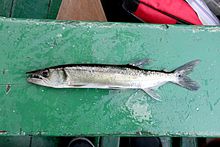Real tetras
| Real tetras | ||||||||||||
|---|---|---|---|---|---|---|---|---|---|---|---|---|

Red neon ( Paracheirodon axelrodi ) |
||||||||||||
| Systematics | ||||||||||||
|
||||||||||||
| Scientific name | ||||||||||||
| Characidae | ||||||||||||
| Latreille , 1825 |
The family of the real tetras (Characidae) is with over 1100 species the largest family of the tetra and the fourth most species- rich family of bony fish . The fish live in Texas , over Mexico to Central America and in South America to Central Argentina .
The family includes many small species of freshwater ornamental fish , e.g. B. the neon fish ( Paracheirodon ).
features
Real tetra have an elongated or high-backed shape that is strongly compressed at the sides. The caudal fin is always forked, sometimes the lower part is extended or the central rays are elongated, the anal fin long, an adipose fin is present in almost all species. The maxilla is edentulous or edentulous, the premaxillary has one or two rows of teeth, in the genera Brycon and Creagrutus there are three to four. The lower jaw has one or two rows, often multi-pointed teeth. The shape and arrangement of teeth are an important differentiator in taxonomy .
Many tetras are very colorful and have iridescent colored drawings. In the skin of these animals there are guanophores under a layer interspersed with colored chromatophores , which reflect the little sunlight that penetrates. It is believed that it is used in the dark rainforest waters for species recognition and the cohesion of swarms.
Most tetra are small fish that grow to be less than four inches. The smallest species only reaches 1.3 centimeters.
Way of life
Real tetras live in a wide variety of habitats and ecological niches. They inhabit both the surface region and the water floor. There are species hidden in plants, inhabitants of open water and cave dwellers. Most are schooling fish, but there are also solitary animals. The fish usually spawn in pairs, after a courtship that often consists of parallel swimming and circumnavigations, freely between plant populations in which the sticky eggs get caught. Some species also spawn in caves or dig spawning pits in the bottom of the water. In the subfamily Stevardiinae there are species with internal fertilization.
The diet of the real tetras is very diverse. There are omnivores, herbivores and small animal eaters, as well as pronounced predatory fish.
External system
The true tetras, together with five other species and subfamilies that were formerly part of the true tetras, and the hatchet-bellied tetras (Gasteropelecidae) form an unnamed monophyletic clade of American tetras for the most part. The sister group of this clade is the genus Chalceus , which was also placed in the true tetras in the past, but is now the only genus of the Chalceidae family. Sister group of Chalceidae and the family group around the real tetras is a common clade of slender tetras (Lebiasinidae) and American pike tetras (Ctenoluciidae).
The following cladogram shows the likely family relationships :

|
|
|
||||||||||||||||||||||||||||||||||||||||||||||||
|
|
Internal system
The real tetras are morphologically very conservative. It is therefore difficult to find a coherent internal system of the family. Here the system of the Argentine ichthyologist Marcos Mirande is followed, who compared 520 morphological characteristics of 259 tetra species with each other, also used molecular biological data and divided the real tetra into eight subfamilies. About 15 genera have an uncertain position to this day and are still listed under incertae sedis . Some groups that used to be run as subfamilies of the true tetras are now considered independent families, the Acestrorhynchidae , Bryconidae , Chalceidae , Iguanodectidae and Triportheidae . This system is also followed in the Catalog of Fishes of the California Academy of Sciences and is reproduced here below:
The following cladogram shows the probable family relationships of the different groups of the true tetras :
|
|||||||||||||||||||||||||||||||||||||||||||||
|---|---|---|---|---|---|---|---|---|---|---|---|---|---|---|---|---|---|---|---|---|---|---|---|---|---|---|---|---|---|---|---|---|---|---|---|---|---|---|---|---|---|---|---|---|---|

-
True tetras (Characidae)
- Subfamily Aphyocharacinae
- Subfamily Characinae
- Subfamily Cheirodontinae
- Subfamily Exodontinae
- Subfamily Spintherobolinae
- Subfamily Stethaprioninae
- Subfamily Stevardiinae
- Subfamily Tetragonopterinae
-
Incertae sedis
- Axelrodia Géry, 1965
- Dectobrycon Zarske & Géry 2006
- Genycharax Eigenmann, 1912
- Leptobrycon Eigenmann, 1915
- Mixobrycon Eigenmann, 1915
- Oligobrycon Eigenmann, 1915
- Oxybrycon Géry, 1964
- Parapristella Géry, 1964
- Schultzites Géry, 1964
- Scissor Günther, 1864
- Serrabrycon Vari, 1986
- Thrissobrycon Böhlke, 1953
- Trochilocharax Zarske, 2010
- Tyttobrycon Géry, 1973
- Tucanoichthys Géry & Römer, 1997
swell
literature
- Kurt Fiedler: Textbook of Special Zoology, Part 2: Fish . 2nd volume. Gustav Fischer Verlag, Jena 1991, ISBN 3-334-00339-6 .
- Joseph S. Nelson : Fishes of the World. 4th edition. John Wiley & Sons, Hoboken NJ et al. 2006, ISBN 0-471-25031-7 .
- Günther Sterba : The world's freshwater fish. 2nd Edition. Urania, Leipzig / Jena / Berlin 1990, ISBN 3-332-00109-4 .
- Juan Marcos Mirande: Phylogeny of the family Characidae (Teleostei: Characiformes): from characters to taxonomy. Neotropical Ichthyology, 8 (3): 385-568, 2010 Copyright © 2010 Sociedade Brasileira de Ictiologia PDF
Individual evidence
- ↑ Claudio Oliveira et al .: Phylogenetic relationships within the speciose family Characidae (Teleostei: Ostariophysi: Characiformes) based on multilocus analysis and extensive ingroup sampling. BMC Evolutionary Biology 2011, 11: 275 doi : 10.1186 / 1471-2148-11-275
- ↑ Bruno F. Melo, Ricardo C. Benine, Gabriel SC Silva, Gleisy S. Avelino, Claudio Oliveira: Molecular phylogeny of the Neotropical fish genus Tetragonopterus (Teleostei: Characiformes: Characidae). Molecular Phylogenetics and Evolution, November 2015, doi: 10.1016 / j.ympev.2015.10.022
- ↑ a b Mirande, JM (2018): Morphology, molecules and the phylogeny of Characidae (Teleostei, Characiformes). Cladistics, June 2018. doi: 10.1111 / cla.12345
- ^ William N. Eschmeyer, Jan D. Fong: Species of Fishes by family / subfamily in the "Catalog of fishes" . 2018 ( online )
Web links
- Real tetras on Fishbase.org (English)
